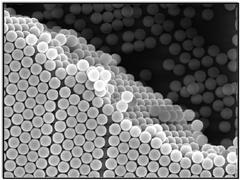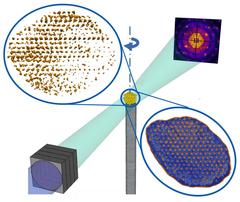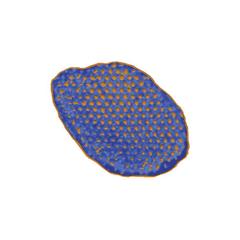URL: https://www.desy.de/news/news_search/index_eng.html
Breadcrumb Navigation
DESY News: Photonic crystals in 3D
News
News from the DESY research centre
Photonic crystals in 3D
Scientists at DESY have developed a method to record the inner structure of individual photonic crystals and similar materials in 3D. The technique directly reveals the positions of the individual building blocks of a crystal, without the need for assumptions, models or averaging. Photonic crystals have a wide range of applications in information technology, chemistry and physics. The team around main author Ivan Vartaniants from DESY reports their work in the scientific journal Physical Review Letters.

More generally, the periodic arrangements of small particles are called colloidal crystals. The characteristics of colloidal crystals strongly depend on their exact inner structure. “For many applications it is vital to understand the real structure of colloidal crystals in every detail,” says co-author Andrei Petukhov from Utrecht University in the Netherlands. For instance, to use them as waveguides in optical information networks it is often crucial to introduce well-defined defects in the crystal structure.
“However, analysing these structures proved to be complicated,” says Vartaniants. “Optical microscopy often does not deliver the necessary spatial resolution. Electron microscopy can see much more details but, since electrons do not penetrate far below the surface, the bulk of the crystal remains hidden. X-rays easily traverse the whole crystal and can reveal fine details, but they do not image the crystal, its structure has to be calculated from the way the X-rays are scattered by the sample, usually needing assumptions or models for the structure under investigation.”

The bright, coherent X-ray beam (green) produces a characteristic diffraction pattern on the detector (upper right), from which the shape of the colloidal crystal under investigation and the positions its individual building blocks can be imaged (upper left and lower right). Credit: Anatoly Shabalin and Ivan Vartaniants, DESY
Like in conventional crystallography, the X-rays are diffracted by the crystal lattice, producing a characteristic diffraction pattern on the detector from which the inner structure can be calculated. “But while conventional crystallography concentrates on the positions of bright spots in the diffraction pattern, known as Bragg peaks, the coherent, laser-like illumination of the sample also produces interference patterns in between the Bragg peaks,” explains first author Anatoly Shabalin from DESY. Using this information, the scientists could determine not just the general inner structure of the crystal, but the positions of the individual silica spheres throughout their sample. This analysis directly revealed the individual, three-dimensional inner structure of the crystal, including defects of different types.
“Our method opens up new ways to visualise the inner three-dimensional structure of mesoscopic materials like photonic crystals with coherent X-rays,” says Vartaniants. “Especially with the next generation of X-ray light sources, this technique can pave the way to analyse individual nanocrystals with atomic resolution.”
Apart from DESY and Utrecht University, the following institutions were involved in this work: the Moscow Engineering Physics Institute (Russia), the University of Göttingen (Germany), the A.V. Shubnikov Institute of Crystallography in Moscow (Russia), the Eindhoven University of Technology (the Netherlands), and the NRC Kurchatov Institute in Moscow (Russia).
Reference:
Revealing three-dimensional structure of an individual colloidal crystal grain by coherent X-ray diffractive imaging; A.G. Shabalin, J.-M. Meijer, R. Dronyak, O.M. Yefanov, A. Singer, R.P. Kurta, U. Lorenz, O.Y. Gorobtsov, D. Dzhigaev, S. Kalbfleisch, J. Gulden, A.V. Zozulya, M. Sprung, A.V. Petukhov, and I.A. Vartanyants; Physical Review Letters, 2016; DOI: 10.1103/PhysRevLett.117.138002




